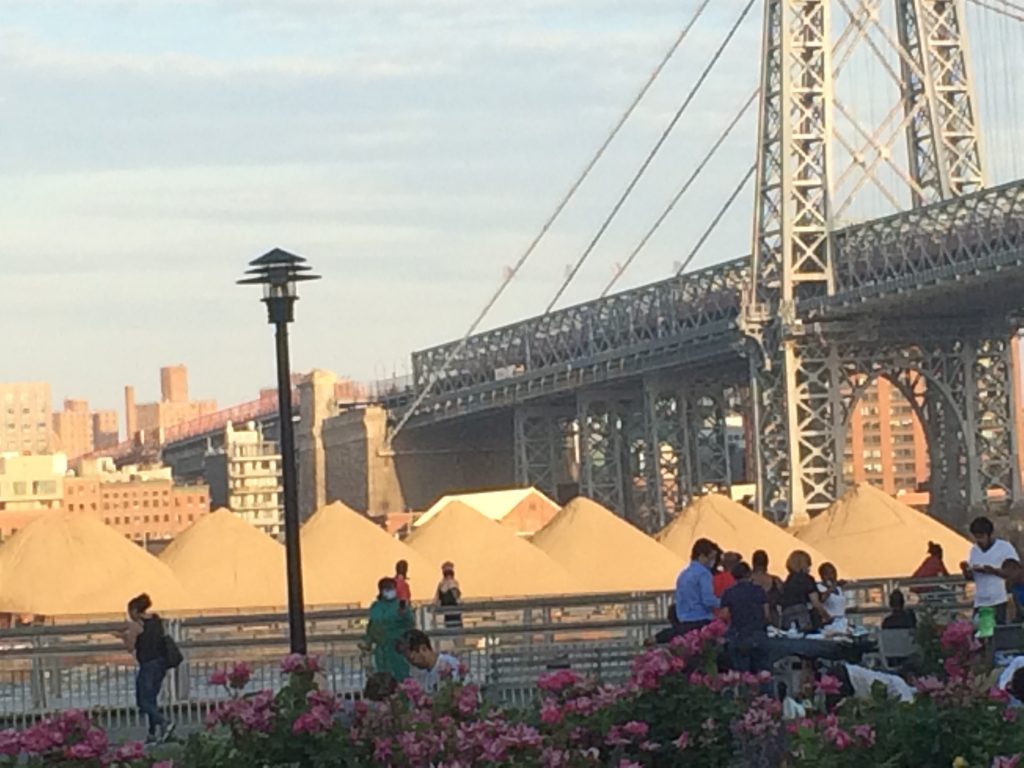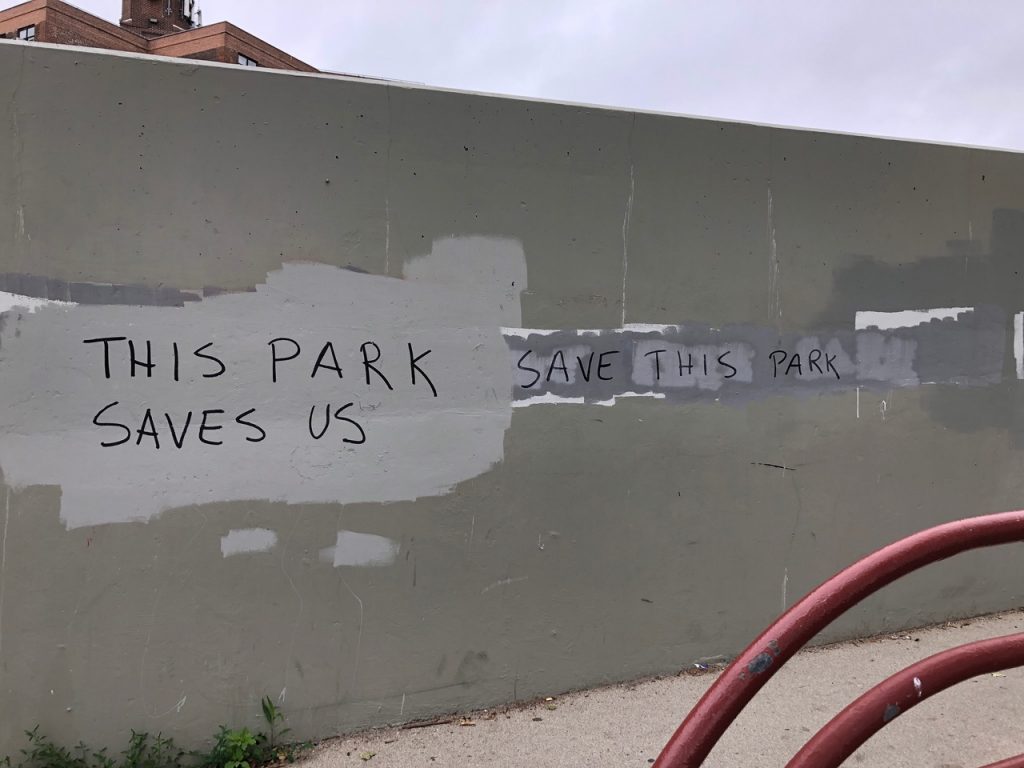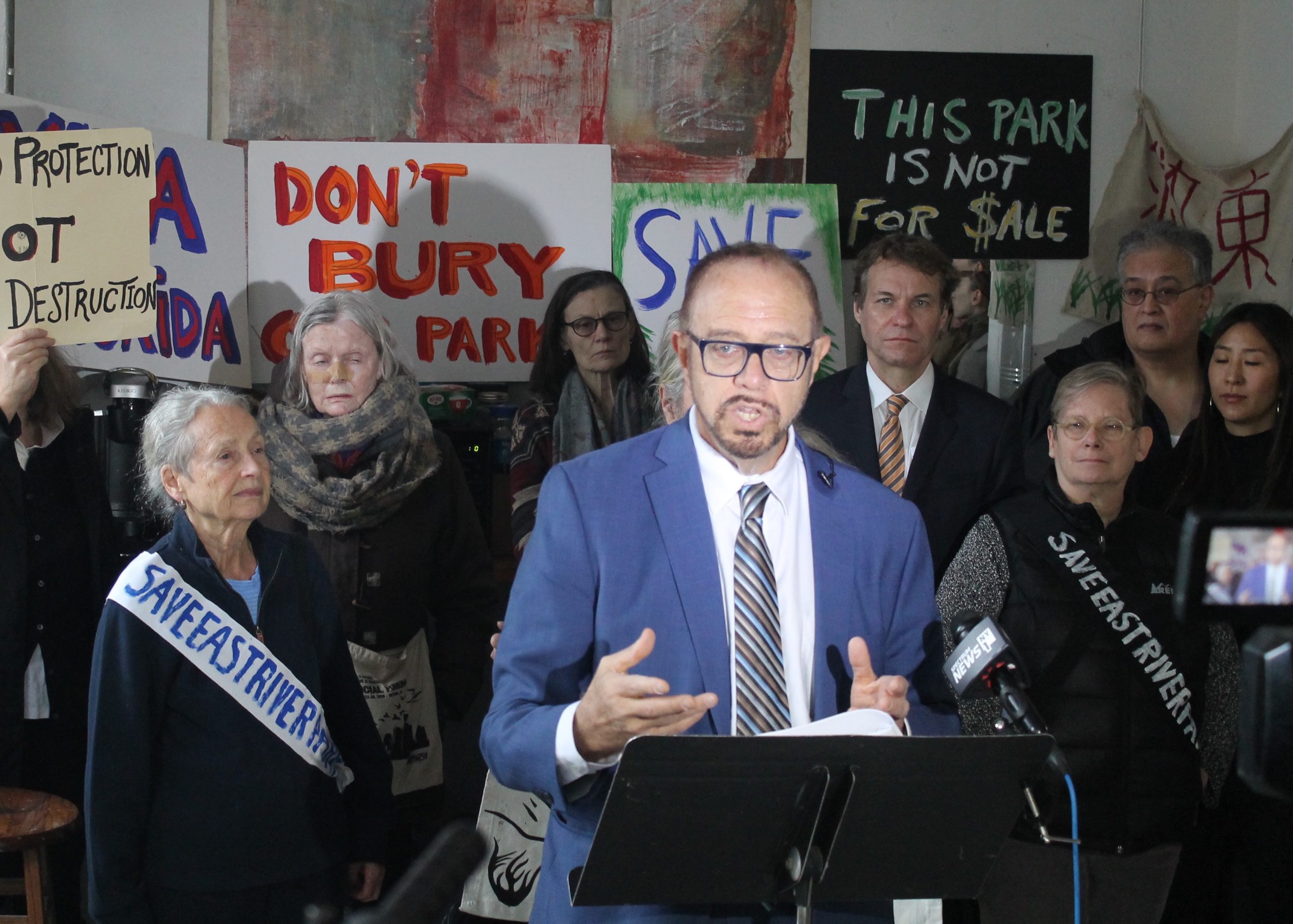BY LINCOLN ANDERSON | Updated Aug. 20, 9:15 p.m.: Residents fighting to save East River Park from being razed and rebuilt for a coastal-resiliency project suffered a painful blow Thursday as a judge ruled for the city.
State Supreme Court Justice Melissa Crane denied the plaintiffs’ request for a restraining order to halt the scheme, clearing the way for work to start in just a few weeks.
It wasn’t immediately clear whether the opponents would appeal the decision.
City Councilmember Carlina Rivera, whose district includes the park and who has been a staunch supporter of the plan, hailed the decision.
“We’ve already seen two tropical storms strike New York City this year,” Rivera told The Village Sun. “It’s clear that for the safety of our community, E.S.C.R. cannot wait any longer. Judge Crane agreed with what City legal experts have affirmed to us all along, and I look forward to this essential project moving ahead with the numerous commitments we secured for it.”
Attorney Arthur Schwartz brought the lawsuit — known as an Article 78, which challenges a city decision — on behalf of 90 organizations and individuals, including the group East River Park ACTION.
The community litigation argues that, under the “public trust doctrine,” the $1.45-billon project needs approval by the state Legislature, which must formally “alienate” the parkland first since the construction would take the park out of public use for at least several years.
The East Side Coastal Resiliency project would bury the existing 1.2-mile-long park under 8 to 9 feet of new topsoil to raise it above the floodplain. Up to 60 percent of the park will be closed at one time during the work.
Closing the park now, however, amid the coronavirus pandemic, when people desperately need open space for social distancing, is a terrible idea, Schwartz stressed. However, Thursday’s hearing before Crane did not focus much on the project’s potential adverse health impacts but on whether E.S.C.R. actually was designed to improve the park or merely turn it into a gigantic flood barrier.
A point that Schwartz tried to stress during the virtual hearing was that the park already is, in effect, resilient. The real damage done by Hurricane Sandy in 2012 was to the community to the west of the park, not to the park itself, he noted.
“We can all agree that the park needs flood protection,” Justice Crane stated at the outset.
But Schwartz countered, “It doesn’t need the same kind of protection as the community adjacent to it needs.”
In fact, the Village attorney stressed that only recently has the de Blasio administration started saying E.S.C.R. is intended to protect or enhance the park.
“It has always been described as a flood-protection system,” he explained.

The project area stretches from E. 23rd St. to Montgomery St. The original, community-approved plan called for a series of simple, protective grassy berms to be build along the eastern edge of the F.D.R. Drive while the park itself would have been left at its current level. Then, abruptly, at the end of 2018, the city changed things up and — without any community input or review — announced it planned to raise the height of the entire park, requiring the total destruction of what’s currently there.
Schwartz noted that the revised project would mean knocking down 991 trees, plus all the park’s shrubs, and all of its built structures.
Crane stressed that the key issue was whether E.S.C.R., at its heart, is being done for a non-park purpose, which then would be “arbitrary and capricious,” in which case it would need to go through the state Legislature.
There was discussion of an earlier precedent, a 2001 lawsuit to stop a water-filtration plant from being built under Van Cortlandt Park, in the Bronx. In that case, the court found for the plaintiffs, agreeing that there was no park-improvement aspect to the project.
Schwartz argued that getting Albany’s approval for E.S.C.R. would mean there would be state oversight of the project, plus the work would be forced to be done on schedule, since the project’s completion date would be written into law. That the work could drag on for years — leaving much of the park off limits to the public — is a big concern for members of the surrounding community.
Furthermore, state approval would also require that the full park, once demolished, would actually be rebuilt, Schwartz added. He also raised the specter of the residential towers in Brooklyn Bridge Park, which were not part of the original plan but were later added to fund that waterfront park.
In short, without state oversight, Schwartz noted, “The city can change its mind. They’re free, frankly, to not restore [the park], or to restore only part of it, or build something else there.”
Meanwhile, the community attorney said the city’s retooled pitch that E.S.C.R. is now needed to protect the park from flooding, well, doesn’t hold water.
Although East River Park flooded during Sandy, he said, “the floodwater receded by the next day. [The park] was muddy. But the water was back in the East River.”
Also, according to Schwartz, during Sandy, the floodwaters mostly came pouring into the East Village and Lower East Side from the north and south, not through East River Park.
Where the flooding’s effects did linger, he said, was not in East River Park but in the basements of buildings in the East Village and Lower East Side.
“Nobody talked — until 2019, when they changed the plan — about ‘We have to save the park,'” Schwartz stressed. “From the F.D.R. all the way over to First Ave., that’s what all the discussion was about. I daresay if [only] the park itself had been flooded and not the community to the west, we wouldn’t be talking about a billion-and-a-half-dollar project.
“Everybody agrees there has to be some kind of a wall,” he acknowledged. “But the purpose at all times has been to protect the community. They went through years of planning, charettes, community meetings. All of sudden, at the end of 2018, 2019, [the city] changed their plan. They didn’t explain why. Suddenly it was a great tragedy that the park had been flooded.”
Also, according to the attorney, all the city’s materials for the E.S.C.R. project from 2015 through 2018-19 anticipated needing to go through the alienation process for East River Park.
On top of everything else, Schwartz said, it would not be arduous or a big delay to have the state Legislature consider the plan since Albany keeps going back into session — instead of recessing from June to January, as usual — this year due to the disruption of the COVID emergency.
“It’s not imposing a horrible burden on the city,” he stressed.
However, Bob Martin, an attorney representing the city, said that the project’s new design — raising the park by 8 to 9 feet — is better because the previous design “would sacrifice East River Park to future flooding.”
In fact, Martin said, according to the city’s projections, if East River Park is not raised, by 2100 it would be flooded twice daily at high tide due to rising sea levels. Basically, he said, the plan was changed both to protect and to improve the park.
Martin added that the city abandoned the idea of building berms along the edge of the F.D.R. Drive due to “constructability issues.”
The E.S.C.R. project will protect 100,000 residents living west of the park, he said.
In addition, East River Park needs hardier trees that are more resistant to the river’s salty air and gusts, the city attorney added, noting that in 2018 more than 250 trees damaged by Sandy were removed from it.

In short, Martin said, the project does have a park purpose since it would “preserve the longevity” of the park — that is, of the new park that would be built, not the existing park.
He added that Community Boards 3 and 6, Manhattan Borough President Gale Brewer and the City Council all approved E.S.C.R.
Martin and Schwartz sparred over another precedent case involving the tiny Petrosino Park that saw Little Italy residents sue the city over the CitiBike station there, arguing that the bikes were not a park purpose. Martin noted that the judge in that case ruled the bikes did have a park purpose since they help people visit and leave the park.
“Their lead case is the Petrosino case — it’s a postage stamp,” Schwartz said, incredulously. “That’s their main case.”
Basically, in addition to saying that bikes are a park use, the judge in that case had ruled that the bike docks were technically outside the park itself, on the plaza ringing the park.
Schwartz also dismissed Martin’s hypothetical argument about twice-daily flooding in East River Park in 2100 as absurd.
“If we get to that point, nobody’s gonna live on the East Side of Manhattan,” he scoffed. “You could build a wall up to 23rd St. At that point, we’re in trouble all over the East Side of Manhattan, not just East River Park.”
After the arguments, Crane took about 25 minutes to consider the case and then ruled from the bench, finding for the city.
“While it is an intrusion,” she said of E.S.C.R., “it is for a park purpose. The project grew to include protecting the park.”
On the other hand, she said, the Van Cortlandt water-filtration project was defeated because it didn’t do anything for that park, such as protect it from climate change, like E.S.C.R. would do for East River Park.
As for Schwartz’s warning that high-rises could spring up in the rebuilt East River Park, Crane said, “At this point, the danger of the city using the park for anything else is speculation.”
She added that that idea of replacing the park’s existing plants with “more substantial flora” is not arbitrary and capricious.
East River Park is important for the neighborhood during the pandemic, she admitted, though suggested that perhaps there is “some other solution” under which people could still have access to the park when the construction work is going on.
Reached for comment after Crane’s ruling, Pat Arnow, a founder of East River Park Action, said, “It’s painful.”
“I think that the law is on our side, but she didn’t see it that way,” she said of the justice’s decision.
She said she doesn’t understand why the city won’t submit the plan to the state Legislature for a vote on whether the park needs to be alienated for the work to proceed.
“What are they afraid of?” she asked.
State Senator Brad Hoylman and Assemblymember Harvey Epstein, whose districts include the park, “would not derail [E.S.C.R.] but would oversee it and set guidelines,” Arnow said.
Meanwhile, she’s skeptical that E.S.C.R. would be done on schedule, especially after the last major project in East River Park — to rebuild its aging esplanade — dragged on forever.
“The last project was 10 years,” she said. “I spent too long looking through chain-link.”
She recalled that the esplanade sat fenced off from 2001 to 2005, when the work finally started, not finishing until 2011.
Also, Arnow said, the community should not have to suffer for the city’s failure to plant durable trees in the park. If the city fells all the existing foliage, it will take years to establish a new tree canopy.
“I’ll never see shade again,” she lamented.


thank you Lincoln. This so called reconstruction for our safety is really misguided. Why do our electeds support this? Shame on Brewer, Rivera and Chin!
Lincoln Anderson, excellent description of complex issues and numerous arguments. Kudos on your coverage and your article!
I honestly don’t know where I am going to go now for a breath of fresh air, greenery, mental health, bicycling–there is so little green space in my area (LES) and NYC certainly hasn’t put forth any alternatives other than cutting down all the mature trees in the NYCHA projects and lining those parks with chainlink fences just for good measure. It is so sad how little the city and “our” representatives care about the health and wellbeing of District 1. This park is just a giant boondoggle that will put us all at increased environmental risk and add to climate change, but the city doesn’t care. Well, I will care when it comes to vote, and I will never support Carlina Rivera, Bill de Blasio, Margaret Chin and all the other uncaring representatives who pushed this terrible plan on us.
Judge Crane determined that: “…replacing the park’s existing plants with ‘more substantial flora’ is not arbitrary and capricious.” Over 60 % of the plant species that the city intends to plant already exist in the park (another 25 % are represented by related plants). Other plants included in the city’s “palette” are large trees that will not survive to maturity, given that the city is planning to remove all vegetation and add another two feet of fill within decades.